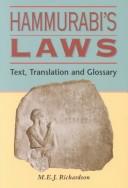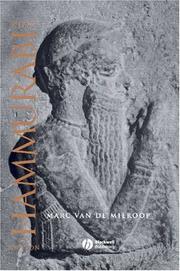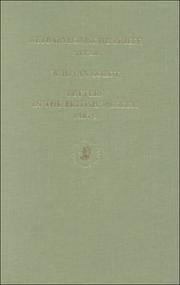| Listing 1 - 10 of 10 |
Sort by
|
Book
Year: 1904 Publisher: Union, N.J. : Lawbook Exchange,
Abstract | Keywords | Export | Availability | Bookmark
 Loading...
Loading...Choose an application
- Reference Manager
- EndNote
- RefWorks (Direct export to RefWorks)
The intention of Ancient Texts and Translations (ATT) is to make available a variety of ancient documents and document collections to a broad range of readers. The series will include reprints of long out-of- print volumes, revisions of earlier editions, and completely new volumes. The understanding of ancient societies depends upon our close reading of the documents, however fragmentary, that have survived.
Book
ISBN: 9004672249 Year: 1993 Publisher: BRILL
Abstract | Keywords | Export | Availability | Bookmark
 Loading...
Loading...Choose an application
- Reference Manager
- EndNote
- RefWorks (Direct export to RefWorks)
Akkadian language --- Assyro-Babylonian letters. --- Texts. --- Hammurabi, --- Correspondence.

ISBN: 0924171316 Year: 1994 Volume: 15 Publisher: Philadelphia, PA : University of Pennsylvania. University Museum,
Abstract | Keywords | Export | Availability | Bookmark
 Loading...
Loading...Choose an application
- Reference Manager
- EndNote
- RefWorks (Direct export to RefWorks)
Assyro-Babylonian literature --- Littérature assyro-babylonienne --- History and criticism. --- Histoire et critique --- Hammurabi, --- -Akkadian literature --- Babylonian literature --- History and criticism --- -History and criticism --- Littérature assyro-babylonienne --- Code of Hammurabi. --- Inu Anum ṣīrum --- Codex Hammurabi --- Sharīʻat Ḥamūrābī --- Codex Ḫammurapi --- Hammurabi's Code --- Hammurabi Code --- Ḫammu-rabi's Laws --- Code of Ḫammu-rabi --- Laws of Ḫammu-rabi --- Codice Ḫammurabi

ISBN: 184127030X 184127139X Year: 2000 Volume: 73 2 Publisher: Sheffield Sheffield Academic Press
Abstract | Keywords | Export | Availability | Bookmark
 Loading...
Loading...Choose an application
- Reference Manager
- EndNote
- RefWorks (Direct export to RefWorks)
Accadian language --- Akkadian (East Semitic) language --- Akkadian language --- Akkadien (Langue) --- Akkadisch (Taal) --- Assyrian language --- Assyro-Babylonian language --- Babylonian language --- Law --- Droit --- Sources --- Hammurabi, --- 299.219 --- Godsdiensten van Babyloniërs en Assyriërs --- 299.219 Godsdiensten van Babyloniërs en Assyriërs --- Hammurabi --- Iraq --- Babylonia
Book
ISBN: 9780197525401 0197525407 9780197525425 Year: 2020 Publisher: New York : Oxford University Press,
Abstract | Keywords | Export | Availability | Bookmark
 Loading...
Loading...Choose an application
- Reference Manager
- EndNote
- RefWorks (Direct export to RefWorks)
"The Laws of Hammurabi is one of the earliest law codes, dating from the 18th century BCE Mesopotamia (ancient Iraq). It is the culmination of a tradition in which scribes would demonstrate their legal flair by composing statutes on a repertoire of traditional cases, articulating what they deemed just and fair. The scribe of the Laws of Hammurabi advanced beyond earlier scribes in composing statutes that manifest systematization and implicit legal principles. The scribe inserted the statutes into the structure of a royal inscription, skillfully reshaping the genre. This allowed the king to use the law code to demonstrate that Hammurabi had fulfilled the mandate to guarantee justice enjoined upon him by the gods, affirming his authority as king. This tradition of scribal improvisation on a set of traditional cases continued outside of Mesopotamia. It influenced biblical law and the law of the Hittite empire and may have shaped Greek and Roman law. The Laws of Hammurabi is also a witness to the start of another stream of intellectual tradition. It became a classic text and the subject of formal commentaries, marking a Copernican revolution in intellectual culture"--
Law, Assyro-Babylonian --- Scribes --- Copyists --- Assyro-Babylonian law --- Sources --- History --- Code of Hammurabi --- Inu Anum ṣīrum --- Codex Hammurabi --- Sharīʻat Ḥamūrābī --- Codex Ḫammurapi --- Hammurabi's Code --- Hammurabi Code --- Ḫammu-rabi's Laws --- Code of Ḫammu-rabi --- Laws of Ḫammu-rabi --- Codice Ḫammurabi --- Influence. --- Babylonia --- Vavilonii︠a︡ --- Bavel --- Bābil --- Babylonien --- Sumer --- Politics and government. --- 892.12 --- 892.12 Assyrische literatuur --- Assyrische literatuur --- Sources.
Book
ISBN: 1283402904 9786613402905 311026451X 3110264501 Year: 2011 Publisher: Berlin ; Boston : Walter de Gruyter,
Abstract | Keywords | Export | Availability | Bookmark
 Loading...
Loading...Choose an application
- Reference Manager
- EndNote
- RefWorks (Direct export to RefWorks)
La présente étude cherche à éclaircir le principe du talion à partir de ses premières attestations dans les droits du Proche-Orient ancien. Elle essaie de démontrer que le talion ne se limite pas à une conception pénale, mais qu'il a existé également sous une forme réparatrice. Cette argumentation repose sur une analyse du formulaire du talion, qui interprète les versets bibliques dans le contexte des modèles cunéiformes, et qui s'étend jusqu'aux témoins de la Méditerranée datant des premiers siècles de notre ère. Le talion ressort ainsi comme un principe de justice qui est à l'origine complet et constructif, et qui ne se laisse pas réduire à une notion purement punitive.
Lex talionis --- Punishment --- History. --- Book of the Covenant. --- Code of Hammurabi. --- Law of the Twelve Tables. --- Retributive Justice. --- Talion.

ISBN: 1405126604 1405126590 Year: 2005 Volume: *1 Publisher: Malden ; Oxford ; Victoria Blackwell Publishing
Abstract | Keywords | Export | Availability | Bookmark
 Loading...
Loading...Choose an application
- Reference Manager
- EndNote
- RefWorks (Direct export to RefWorks)
Hammurabi, --- Babylonia --- History. --- Kings and rulers --- Khammurabi, --- Hammurapi, --- Chammurapi, --- Hamurabi, --- Hammourabi, --- Hammu-rapi, --- חמורבי, --- حمورابي. --- Vavilonii︠a︡ --- Bavel --- Bābil --- Babylonien --- Sumer

ISBN: 9004099484 9789004099487 9004672249 9789004672246 Year: 1993 Volume: 13 Publisher: Leiden ;Boston Brill
Abstract | Keywords | Export | Availability | Bookmark
 Loading...
Loading...Choose an application
- Reference Manager
- EndNote
- RefWorks (Direct export to RefWorks)
Akkadian language --- Assyro-Babylonian letters. --- Texts. --- -Assyro-Babylonian letters --- Akkadian letters --- Assyro-Babylonian literature --- Accadian language --- Assyrian language --- Assyro-Babylonian language --- Babylonian language --- Semitic languages --- Texts --- Hammurabi King of Babylonia --- -Correspondence --- Assyro-Babylonian letters --- Hammurabi, --- Khammurabi, --- Hammurapi, --- Chammurapi, --- Hamurabi, --- Hammourabi, --- Hammu-rapi, --- חמורבי, --- حمورابي. --- Correspondence. --- Akkadian language - Texts
Book
ISBN: 9780195304756 0195304756 019986683X 0199885397 0199974950 9786612335617 1282335618 0199719527 Year: 2009 Publisher: Oxford: Oxford university press,
Abstract | Keywords | Export | Availability | Bookmark
 Loading...
Loading...Choose an application
- Reference Manager
- EndNote
- RefWorks (Direct export to RefWorks)
Law, Ancient --- Law --- Sources. --- Book of the Covenant --- Code of Hammurabi. --- Bible. --- Criticism, interpretation, etc. --- Extra-canonical parallels. --- 221.08*2 --- 221.08*2 Theologie van het Oude Testament: moraal; ethica; juridica Israelis; vroomheid --- Theologie van het Oude Testament: moraal; ethica; juridica Israelis; vroomheid --- Acts, Legislative --- Enactments, Legislative --- Laws (Statutes) --- Legislative acts --- Legislative enactments --- Jurisprudence --- Legislation --- Ancient law --- Sources --- Inu Anum ṣīrum --- Codex Hammurabi --- Sharīʻat Ḥamūrābī --- Codex Ḫammurapi --- Hammurabi's Code --- Hammurabi Code --- Ḫammu-rabi's Laws --- Code of Ḫammu-rabi --- Laws of Ḫammu-rabi --- Codice Ḫammurabi --- Bundesbuch --- Covenant Code --- Antico Testamento --- Hebrew Bible --- Hebrew Scriptures --- Kitve-ḳodesh --- Miḳra --- Old Testament --- Palaia Diathēkē --- Pentateuch, Prophets, and Hagiographa --- Sean-Tiomna --- Stary Testament --- Tanakh --- Tawrāt --- Torah, Neviʼim, Ketuvim --- Torah, Neviʼim u-Khetuvim --- Velho Testamento --- Law, Ancient - Sources. --- Law - Middle East - Sources.
Book
ISBN: 9780691149974 9780691137223 0691137226 9781400832873 140083287X 0691149976 Year: 2011 Publisher: New Jersey Princeton University Press
Abstract | Keywords | Export | Availability | Bookmark
 Loading...
Loading...Choose an application
- Reference Manager
- EndNote
- RefWorks (Direct export to RefWorks)
In Civilizations of Ancient Iraq, Benjamin and Karen Foster tell the fascinating story of ancient Mesopotamia from the earliest settlements ten thousand years ago to the Arab conquest in the seventh century. Accessible and concise, this is the most current and authoritative book on the subject. With illustrations of important works of art and architecture in every chapter, the narrative traces the rise and fall of successive civilizations and peoples in Iraq over the course of millennia--from the Sumerians, Babylonians, and Assyrians to the Persians, Seleucids, Parthians, and Sassanians. Ancient Iraq was home to remarkable achievements. One of the birthplaces of civilization, it saw the world's earliest cities and empires, writing and literature, science and mathematics, monumental art, and innumerable other innovations. Civilizations of Ancient Iraqgives special attention to these milestones, as well as to political, social, and economic history. And because archaeology is the source of almost everything we know about ancient Iraq, the book includes an epilogue on the discovery and fate of its antiquities. Compelling and timely, Civilizations of Ancient Iraqis an essential guide to understanding Mesopotamia's central role in the development of human culture.
Civilization, Assyro-Babylonian. --- Assyria --- Babylonia --- Iraq --- Antiquities. --- Social life and customs. --- History --- Civilization, Assyro-Babylonian --- Assyro-Babylonian civilization --- Babylonian civilization --- Civilization, Babylonian --- Vavilonii︠a︡ --- Bavel --- Bābil --- Babylonien --- Sumer --- Afghanistan. --- Akkadian literature. --- Alexander the Great. --- Amorites. --- Amu Darya River. --- Annunitum. --- Archimedes screw. --- Assurbanipal. --- Assyriology. --- Babylon, site. --- Balikh River. --- Berlin Museum. --- British Museum. --- Carchemish. --- Chaldaean Catholics. --- Christianity. --- Damascius. --- Eannatum. --- Erlenmeyer Collection. --- Esarhaddon. --- Gaugamela. --- Gnosticism. --- Greek language. --- Hammurabi. --- Hassuna ware. --- Iraq Museum. --- Jeremiah. --- Jesus. --- Julius Caesar. --- Kudur-nahhunte. --- Lachish. --- Manishtusu. --- Nabopolassar. --- accounting. --- astronomy. --- bevel-rimmed bowls. --- caravanserais. --- chronicles. --- decipherment. --- domestication. --- education. --- families. --- fertility. --- frankincense. --- furniture. --- horoscopes. --- iconography. --- kudurrus. --- literacy. --- mathematics. --- minstrels.
| Listing 1 - 10 of 10 |
Sort by
|

 Search
Search Feedback
Feedback About UniCat
About UniCat  Help
Help News
News